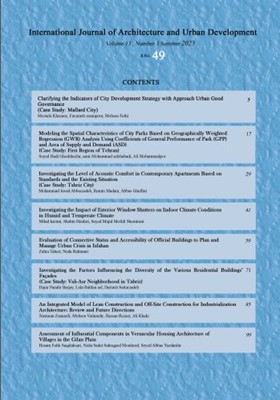Investigating the Impact of Exterior Window Shutters on Indoor Climate Conditions in Humid and Temperate Climate
محورهای موضوعی : Built Environment
Milad karimi
1
![]() ,
Shahin Heidari
2
,
Seyed Majid Mofidi Shemirani
3
,
Shahin Heidari
2
,
Seyed Majid Mofidi Shemirani
3
1 - Department of Art and Architecture, West Tehran Branch, Islamic Azad University ,Tehran, Iran.
2 - Department of Architecture, University of Tehran, Tehran, Iran.
3 - Department of Architecture, Iran University of Science and Technology, Tehran, Iran.
کلید واژه: Vernacular Architecture, Building envelope, Hydrothermal Performance, Window Shutter,
چکیده مقاله :
Improving the thermal comfort of occupants in indoor spaces is one of the objectives of improving building construction techniques. In temperate and humid climates, window shutters are utilized as a protective shield during storms. They can also block the view from the outside environment into the room. In this study, we looked into how the inner climate condition was affected by various design patterns of these flexible envelopes. Vernacular architecture in humid and temperate climates can be used to describe different window shutter sizes and shapes. These shutters include both entirely rigid or perforated types. Window shutters are utilized as adjustable enclosures outside building windows that allow occupants to adjust their position or location. Occupants in this area frequently open windows during extreme heat to ventilate the building and enhance the inner climate.In this regard, while using natural ventilation, we compared the twelve sample models with window shutters with various opening inlets to those without these flexible envelopes. We concluded after looking at several variables that flexible envelopes with an inlet area of 12.5% to 25% of the flexible envelopes produce better inner climate conditions.
Bagarić, M., Banjad Pečur, I., & Milovanović, B. (2020). Hygrothermal performance of ventilated prefabricated sandwich wall panel from recycled construction and demolition waste – A case study. Energy and Buildings, 206, 109573.
Desta, T. Z., Langmans, J., & Roels, S. (2011). Experimental data set for validation of heat, air, and moisture transport models of building envelopes. Building and Environment, 46(5), 1038-1046.
Gao, C. F., & Lee, W. L. (2011). Evaluating the influence of openings configuration on natural ventilation performance of residential units in Hong Kong. Building and Environment, 46(4), 961-969.
Ghiabaklou, Z. (2013). Fundamentals of Building Physics 4: Passive Cooling [Fundamentals of Building Physics 4 - Passive Cooling]. Publication of Jihad Amirkabir University. "Persian"
Glass, S., TenWolde, A., & Zelinka, S. (2013). Hygrothermal Simulation: A Tool for Building Envelope Design Analysis. Wood Design Focus, 23,18-25.
Golabchi, M., Andaji Garmaroodi, A., & Bastani, H. (2012). Digital Architecture: CAD/CAM/CAE Technologies Application in Architecture (2nd ed.). University of Tehran Press. "Persian"
Karagiozis, A. (2020). Impact of Air Leakage on the Thermal and Moisture Performance of the Building Envelope in Conference: Air Barriers III: Air Barrier Solutions for Buildings in North American Climates, United States.
Karagiozis, A., & Salonvaara, M. (2001). Hygrothermal system performance of a whole building. Building and Environment, 36, 779-787.
Kasmai, M. (2003). Climate and Architecture (M. Ahmadinezhad, Ed. 2nd ed.), Isfahan: Khak publication. "Persian"
Košir, M. (2016). Adaptive Building Envelope: An Integral Approach to Indoor Environment Control in Buildings. In Automation and Control Trends.
Le, A. D. T., Samri, D., Rahim, M., Douzane, O., Promis, G., & Langlet, T. (2015). Effect of Temperature-dependent Sorption Characteristics on The Hygrothermal Behavior of Hemp Concrete. Energy Procedia, 78, 1449-1454.
Montalbán Pozas, B., & Neila González, F. J. (2016). Hygrothermal behaviour and thermal comfort of the vernacular housings in the Jerte Valley (Central System, Spain). Energy and Buildings, 130, 219-227.
Parker, P., & Lozinsky, C. (2010). Thermal and hygrothermal analysis in building envelope commissioning. In NIBS Building Enclosure Science & Technology Conference. National Institute of Building Sciences (NIBS) (pp. 12-14).
Galogahi, S. Z., Majidaee, M., Beheshti, H. M., & Alishah, M. (2016). Effects of window position on natural cross ventilation in vernacular architecture of Mazandaran (Case study: Sari). Journal of Fundamental and Applied Sciences, 8(2), 567-586.
Salonvaara, M., & Ojanen, T. (2003). Indoor Air Humidity Variations And Its Effects On The Moisture Performance Of Building Envelopes. Building Simulation, 8, 1163-1170
Shahin, H. S. M. (2019). Adaptive building envelopes of multistory buildings as an example of high-performance building skins. Alexandria Engineering Journal, 58(1), 345-352.
Soltanzadeh, H., & Ghaseminia, M. (2016). Climatic Building Envelope Employed In Vernacular Residential Architecture In Golestan-Iran. International Journal of Architecture and Urban Development, 6(1 (19)), -.
Paepe, M., & Janssens, A. (2010). Impact of whole-building hygrothermal modelling on the assessment of indoor climate in a library building. Building and Environment, 45(7), 1641-1652.
Tadeu, A., Škerget, L., Simões, N., & Fino, R. (2018). Simulation of heat and moisture flow through walls covered with uncoated medium-density expanded cork. Building and Environment, 142, 195-210.


